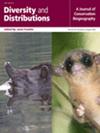Multiple Threshold-Selection Methods Are Needed to Binarise Species Distribution Model Predictions
Abstract
Aim
Probabilities of occurrence predicted by species distribution models (SDMs) are routinely binarised based on a threshold that maximises the true skill statistic. Recently, the true skill statistic is criticised for favouring overprediction when species' prevalence is low. We aim to assess the effect of three alternative threshold-selection methods on predicted range sizes and changes therein under climate change across a large number of species in Europe.
Location
Europe.
Methods
We fitted SDMs for 1677 vascular plant species, using species observations from 431,179 vegetation plots as response variables and climate, soil and topographic variables as predictors. We used the SDMs to quantify current and future range sizes of each species under mild and severe climate change scenarios, each combined with two dispersal assumptions (no and unlimited dispersal) and using four threshold-selection methods: maximising true skill statistic (TSS), minimising the difference between sensitivity and specificity (DSS), maximising Matthew's correlation coefficient (MCC) and maximising F-measure (F). Further, we assessed prediction errors for each threshold-selection method in relation to species prevalence.
Results
We found that SDM outputs binarised with TSS resulted in the largest predicted ranges and the smallest future range contractions. For current climate conditions, median range sizes were 1.3, 3.6 and 9.2 times larger when binarised with TSS than with DSS, MCC and F, respectively. Under severe climate change without dispersal, median range size declines were 56%, 61%, 79% and 88% with TSS, DSS, MCC and F, respectively. Binarisation based on TSS tended to result in the highest overprediction rates and lowest underprediction rates, while this was the opposite with F.
Main Conclusions
We recommend choosing the threshold-selection method based on the goals and scope of the study, while carefully considering the trade-offs between overprediction and underprediction. Alternatively, we recommend using multiple threshold-selection methods to quantify the uncertainty in the binarisation.


 求助内容:
求助内容: 应助结果提醒方式:
应助结果提醒方式:


